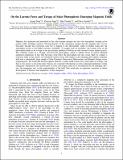Files in this item
On the Lorentz force and torque of solar photospheric emerging magnetic fields
Item metadata
| dc.contributor.author | Duan, Aiying | |
| dc.contributor.author | Jiang, Chaowei | |
| dc.contributor.author | Toriumi, Shin | |
| dc.contributor.author | Syntelis, Petros | |
| dc.date.accessioned | 2020-07-16T10:30:02Z | |
| dc.date.available | 2020-07-16T10:30:02Z | |
| dc.date.issued | 2020-06-09 | |
| dc.identifier | 269040559 | |
| dc.identifier | 812c858b-d819-486d-a0fd-7dc2c8b3c61f | |
| dc.identifier | 85086931086 | |
| dc.identifier | 000541481900001 | |
| dc.identifier.citation | Duan , A , Jiang , C , Toriumi , S & Syntelis , P 2020 , ' On the Lorentz force and torque of solar photospheric emerging magnetic fields ' , Astrophysical Journal Letters , vol. 896 , no. 1 , L9 . https://doi.org/10.3847/2041-8213/ab961e | en |
| dc.identifier.issn | 2041-8205 | |
| dc.identifier.other | ORCID: /0000-0002-6377-0243/work/77131792 | |
| dc.identifier.uri | https://hdl.handle.net/10023/20269 | |
| dc.description | This work is supported by the startup funding (74110-18841214) from Sun Yat-sen University. C.J. acknowledges support by the National Natural Science Foundation of China (41822404, 41731067, 41574170, and 41531073). S.T. was supported by JSPS KAKENHI grant Nos. JP15H05814 (PI: K. Ichimoto) and JP18H05234 (PI: Y. Katsukawa), and by the NINS program for cross-disciplinary study (grant Nos. 01321802 and 01311904) on Turbulence, Transport, and Heating Dynamics in Laboratory and Solar/Astrophysical Plasmas: “SoLaBo-X.” P.S. acknowledges support by the ERC synergy grant “The Whole Sun.” Data from observations are courtesy of NASA SDO/HMI science teams. | en |
| dc.description.abstract | Magnetic flux generated and intensified by the solar dynamo emerges into the solar atmosphere, forming active regions (ARs) including sunspots. Existing theories of flux emergence suggest that the magnetic flux can rise buoyantly through the convection zone but is trapped at the photosphere, while its further rising into the atmosphere resorts to the Parker buoyancy instability. To trigger such an instability, the Lorentz force in the photosphere needs to be as large as the gas pressure gradient to hold up an extra amount of mass against gravity. This naturally results in a strongly non-force-free photosphere, which is indeed shown in typical idealized numerical simulations of flux tube buoyancy from below the photosphere into the corona. Here we conduct a statistical study of the extents of normalized Lorentz forces and torques in the emerging photospheric magnetic field with a substantially large sample of Solar Dynamics Observatory/Helioseismic and Magnetic Imager vector magnetograms. We found that the photospheric field has a rather small Lorentz force and torque on average, and thus is very close to a force-free state, which is not consistent with theories as well as idealized simulations of flux emergence. Furthermore, the small extents of forces and torques seem not to be influenced by the emerging AR's size, the emergence rate, or the nonpotentiality of the field. This result puts an important constraint on future development of theories and simulations of flux emergence. | |
| dc.format.extent | 8 | |
| dc.format.extent | 873434 | |
| dc.language.iso | eng | |
| dc.relation.ispartof | Astrophysical Journal Letters | en |
| dc.subject | Solar magnetic fields | en |
| dc.subject | Solar photosphere | en |
| dc.subject | QB Astronomy | en |
| dc.subject | Astronomy and Astrophysics | en |
| dc.subject | Space and Planetary Science | en |
| dc.subject | 3rd-DAS | en |
| dc.subject.lcc | QB | en |
| dc.title | On the Lorentz force and torque of solar photospheric emerging magnetic fields | en |
| dc.type | Journal article | en |
| dc.contributor.sponsor | European Research Council | en |
| dc.contributor.institution | University of St Andrews. Applied Mathematics | en |
| dc.identifier.doi | https://doi.org/10.3847/2041-8213/ab961e | |
| dc.description.status | Peer reviewed | en |
| dc.identifier.grantnumber | 810218 | en |
This item appears in the following Collection(s)
Items in the St Andrews Research Repository are protected by copyright, with all rights reserved, unless otherwise indicated.

